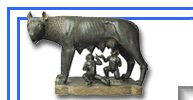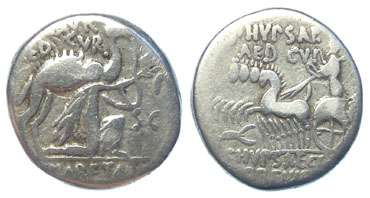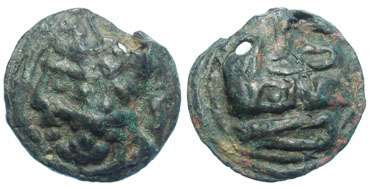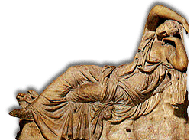THE AES RUDE COINAGE
AES RUDE (crude bronze), the earliest type of Roman
money, was probably first used about 400 B.C. as small, irregular lumps
of bronze broken from cast thick sheets. There is no set weight
standard, nor normally any mark of an issuing authority, so they cannot
be called true coins. They would have circulated as bullion items which
would have been weighed at each transaction, in much the same way that
gold nuggets were used as currency during the 19th century gold rushes
in Alaska and California.
Although no longer available for sale, the specimen we
recently had (link to image)
was unusual because on it's single flat surface there is a stamped
incuse leaf pattern which was on the original block of bronze prior to
it being broken into fragments. The exact meaning of this stamping will
probably remain unknown, although it may have been some type of quality
control mark on the bar. Assuming each bar had a single stamping of
this nature (which is by no means certain), this is a feature that
should only be found on a small percentage of the Aes rude.
THE AES SIGNATUM COINAGE
AES SIGNATUM (signed bronze) replaced the aes rude
sometime around the beginning of the third century B.C. as cast,
generally rectangular ingots, with raised designs. These may have been
true coins as they appear to meet the three basic requirements: First,
they had an intrinsic value related to their circulating value
(otherwise they would be tokens). Second, they appear to bear the mark
of an issuing authority (The locals must have known the meanings of the
symbols, and one type is even inscribed "ROMANOM"). Third, they
were cast to a weight standard (ca 1600 grams), so they would not have
to be weighed for each transaction. Unfortunately, there appears to
have been only one denomination, so they are often found cut into
fragments, the only way of making change. The system was unwieldy, and
doomed to failure.
THE AES GRAVE COINAGE
The AES GRAVE were cast bronze coins, generally round,
with several different denominations. They replaced the Aes Signatum
almost immediately, probably after only a few years. Through several
changes in design and weight standards, this was probably the principal
coinage used in the city of Rome until about 215 B.C., overlapping with
the earliest struck silver coins which were probably used primarily for
trade with Greek cities and not used much in Rome.
ANONYMOUS STRUCK COINAGE
ANONYMOUS die struck coins first appear around 280 B.C.
The earliest examples were generally silver, and except for being
inscribed for Rome, were very similar to the didrachms and drachms
struck in Metapontum and some other Greek cities in southern Italy. The
types and style are in fact so close that the dies were almost
certainly cut by the Greek die engravers in those cities, and it is
possible that they were struck there for the Romans. It seems likely
these coins were made for trade purposes and seldom used in Rome.
Later, probably around 250 B.C. struck bronze coins were first made,
but of distinctly Roman designs.
About 225 B.C. saw the introduction of a didrachm
usually referred to as a quadrigatus. This was the first Roman silver
coin that was distinctly Roman in style, and almost certainly minted in
Rome. The name quadrigatus comes from the quadriga or four-horse
chariot on the reverse, which was the prototype for the designs most
used on Roman silver coins for the next 150 years.
Around 211 B.C. we see the introduction of the silver
denarius and a short-lived denomination called the victoriatus. Denarii
were struck for use in areas under Roman control and would remain the
principal coin of the Mediterranean world for the next 450 years.
Victoriati were probably struck for use in trade with the Greek cities
of southern Italy, and ceased to be struck as soon as the Romans
conquered those territories.
Although most references list the first big issues of
denarii as occurring in about 211 BC, I personally believe a date of
about 209 BC is more likely. Prior to that the Romans did not control
any area rich in silver, which is why silver coins were not generally
issued in earlier periods. In about 209 BC, during the 2nd Punic War,
the Roman captured the Spanish city of Carthago Nova and took control
of the silver mines associated with that city.
COINAGE NAMING MONEYERS
MONEYERS, under the Roman Republic, were elected
officials who were responsible for the minting of coins. After about
206 B.C. they were allowed to place their names on the coins, although
some anonymous issues were struck as late as the early first century
BC. The early inscribed denarii tended to have a helmeted bust of Roma
on the obverse, with either Victory in a galloping chariot, or the
Dioscuri (Castor and Pollux) galloping right on the reverse. The
victoriatus was always struck with the head of Jupiter on the obverse
and Victory crowning a trophy on the reverse.
The bronze coins also used conservative formal designs,
usually with a ship's prow on the reverse, with several of the Roman
gods and goddesses on the obverse. The basic bronze coinage remained
largely unchanged until the end of the Republic, except for fewer
denominations and a gradual reduction in weight. There were also silver
quinarii (half denarii) and silver sestertii (quarter denarii) being
struck, but they are uncommon and probably played only a minor role in
Roman commerce.
IMPERATORIAL COINAGE
In 49-48 B.C. the fabric of the Roman Republic was
coming apart with a civil war being fought between the Pompeian forces
lead by Pompey the Great, and those of his former allies, Julius
Caesar. The coinage of this period is commonly known as the
Imperatorial Coinage, but is actually still a sub-group of the
Republican series.
For the next twenty-two years, several warring factions
vied for control of Rome and a series of very famous people appeared on
the coinage. As well as Pompey, the list includes Julius Caesar,
Brutus, Mark Antony (occasionally with Cleopatra on the reverse),
Octavian (later known as Augustus, the first Emperor) and a number of
other less-known, but important people.
|






